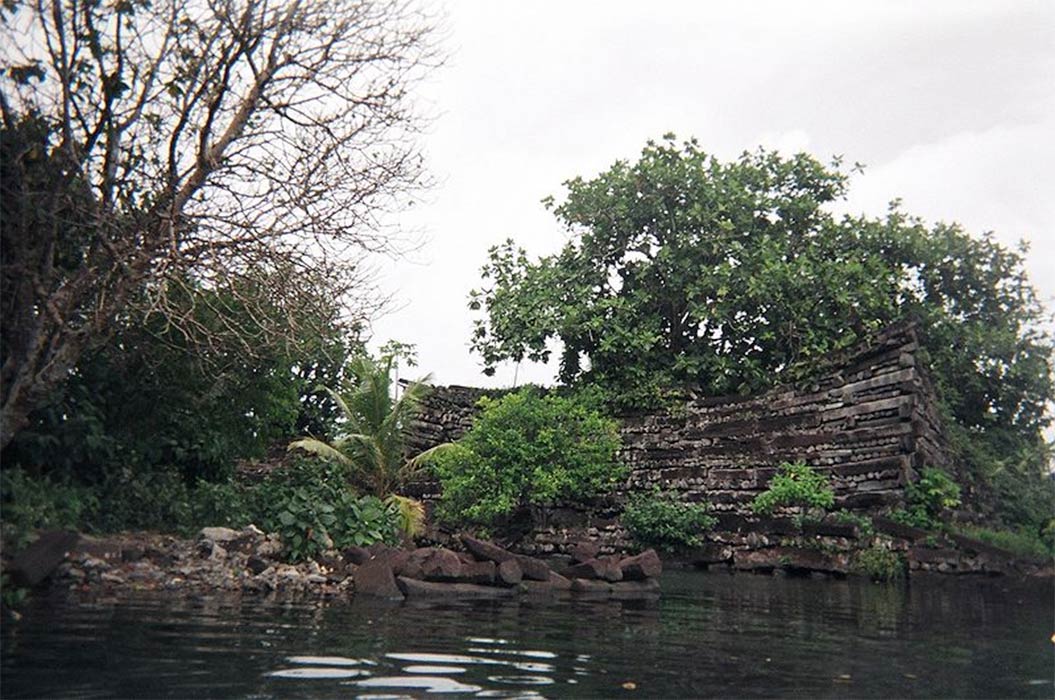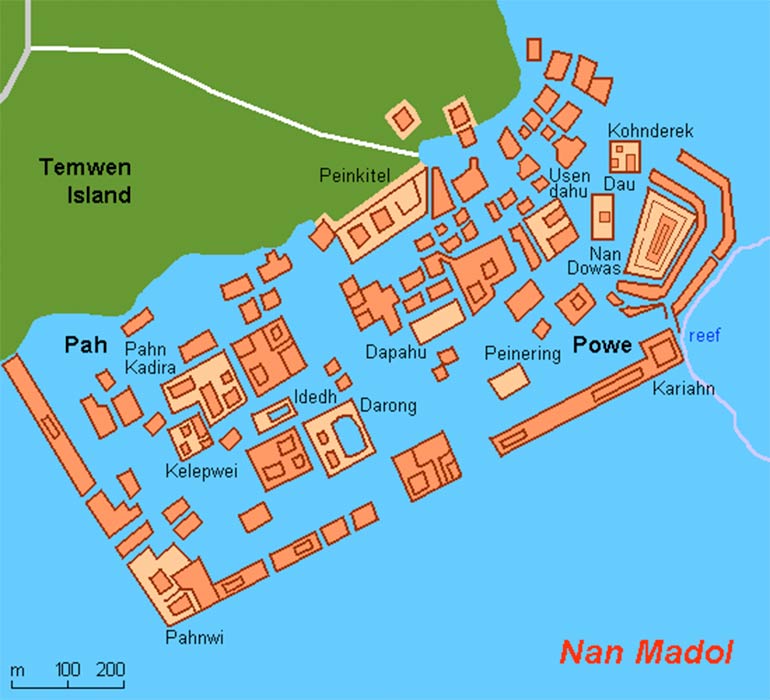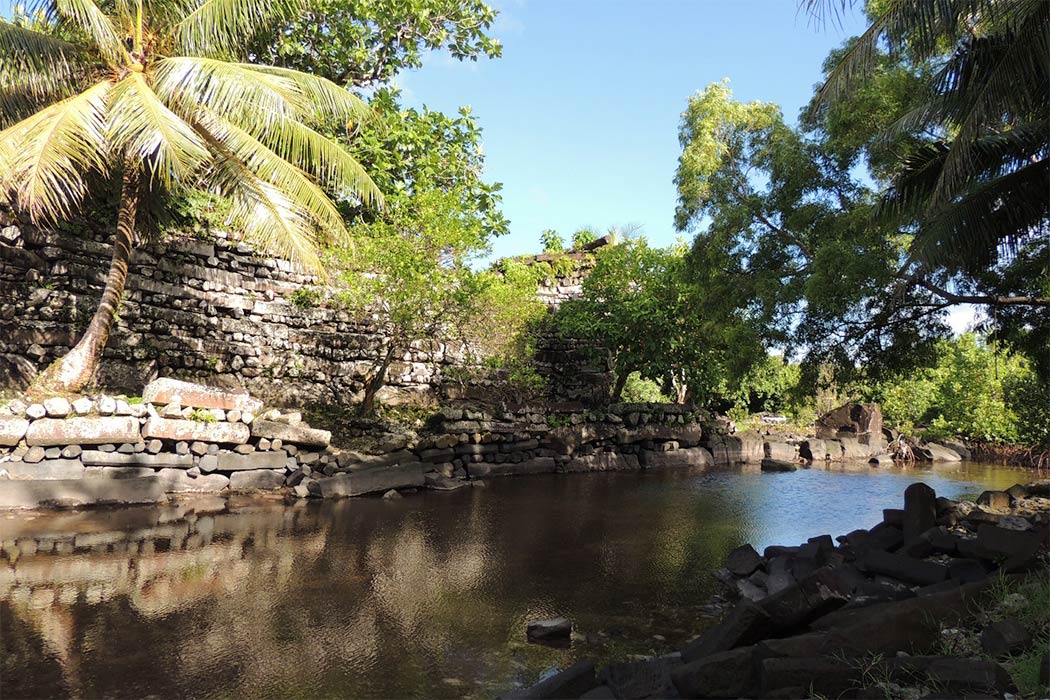
The Enigma Of Nan Madol: Home of Pre-Flood Stone Gods
Nan Madol is a mysterious place, there is nothing like it the world over. Its people are vanished and its purpose spectacularly obscure. Was it built by the mythical brothers Olishipa and Olosohpa, in honor of the god of thunder Daukatau, or to commemorate the sunken cities off the coast?
Known traditionally as Soun Nan-leng (‘Reef of Heaven’), Nan Madol is a megalithic complex made up of over 90 man-made islets built on coral fill and spread 200 acres over a lagoon edging Pohnpei’s surrounding barrier reef. Pohnpei (formerly Ponape) is the third-largest member of the Federated States of Micronesia, a spray of over 600 islands so-named after their minuscule size. Pohnpei is a compound meaning ‘upon an altar’, in reference to a cloud-capped mountain at the island’s center: at its summit is a basalt altar and a mangrove tree which symbolically represents the birth of the isle from its ocean bed. Nan Madol, popularly referred to as the ‘Venice of the Pacific’ perches upon the southeastern coastline of Pohnpei. Nan Madol means ‘spaces between’.

Map of Nan Madol. Federated States of Micronesia (Public Domain)
Venice Of The Pacific
The rectangular buildings of this megalithic metropolis are assembled out of massive boulders and tidily stacked piles of prismatic basalt. The four-to eight-sided columns of this dark, dense and smooth material formed millions of years ago. Guarding Nan Madol from battering ocean tides are the ruins of breakwaters along its coast, while running around and in between the islets is a network of connecting waterways. Today, the majority of crisscrossing canals are glutted with mangrove swamps, while thick tropical growth smothers nearly all of the islets. If left unchecked, the invasion of jungle will devour the entire site - and initiatives to restrain it are not forthcoming. Pohnpei is a hotspot attracting divers and big fish anglers, but sadly not visitors to its megalithic ruins. Many native Pohnpeians are also loath to visit the site, especially at night, since they believe Nan Madol is haunted by ancient spirits which should not be disturbed.
Currently it is thought construction of the site dates back no more than 1,500 years, although earlier foundations have been documented along with evidence of remodelling by successive occupants. Modern scientific research of the complex began in the 1960s and has largely been confined to topography and surface inspection.

Pool at Nandauwas (Image: © Alistair Coombs)
Literary References
The site has unsurprisingly been the subject of several thriller novels with an underwater component, such as James Rollins’ Deep Fathom and Clive Cussler’s Medusa. The renowned author of cosmic horror, H.P. Lovecraft, apparently based his R’lyeh (a sunken city home to alien monsters from outer space) on Nan Madol. One of Lovecraft’s contemporaries, Abraham Merritt, featured the site in his The Moon Pool (1918) which became a popular novel in the 1920-30s. Hidden within the undersea tunnels and caverns of Nan Madol, is a magma chamber, the threshold of a dreaded being known as the Dweller, and the appearance of unusual light phenomena: “ In front of me was a pool. It was circular, perhaps 20 wide. Around it ran a low, softly curved lip of glimmering silvery stone. Its water was the palest blue. The pool with its silver rim was like a great blue eye staring upward. Upon it streamed seven shafts of radiance. They poured down upon the blue eye like cylindrical torrents; they were like shining pillars of light rising from a sapphire floor. One was the tender pink of the pearl; one of the aurora’s green; a third a deathly white; the fourth the blue in mother-of-pearl; a shimmering column of pale amber; a beam of amethyst; a shaft of molten silver. Such are the colors of the seven lights that stream upon the Moon Pool.”(The Moon Pool 1918). Merritt’s fantastic vision aside, placed in front of the seaward wall of a mortuary building named Nandauwas is a tunnel that is said to lead to the lair of a domesticated sea-sky monster in the form of a giant eel that bathes in a pool.
Construction Enigma
Separated by a central waterway, Nan Madol is divided into two main districts. Its southwestern area was allocated to what are thought to have been administrative and residential islets, while its northeastern isles housed its ritual and mortuary temples. The purpose of Nan Madol is not the only conundrum. Much remains obscure and unanswered about how such a colossal amount of basalt was quarried and transported to the site. Some of the stones have been chemically traced to a quarry on Pohnpei’s opposite coastline. How the hundreds of thousands of tons of material was brought here remains an almost impossible question. Was it ferried by raft along the coast or carted for miles over twisted terrains of hill, jungle, and swamp? A cornerstone of the Nandauwas building is estimated to weigh 60 tons, while smaller slabs and shafts commence from about five tons. The sheer quantity of material makes the above transport routes and methods appear bleak. Constructed at a time when no more than 20,000 people inhabited the entire island, Nan Madol is an astounding construction feat, the Pohnpeian equivalent of the Giza pyramids.




